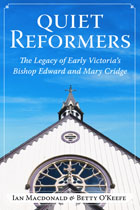Quiet Reformers: The Legacy of Early Victoria’s Bishop Edward and Mary Cridge
Review By Diana Chown
November 4, 2013
BC Studies no. 173 Spring 2012 | p. 151-52
Edward and Mary Cridge’s life in Victoria began in 1855, when the Hudson’s Bay Company’s James Douglas still reigned supreme. By the time Edward died in 1913 the most significant sign of the HBC in Victoria was the construction site where of the new department store was going up. British Columbia, no longer a colony, had been a province of Canada for 42 years.
Ian Macdonald and Betty O’Keefe, who have written several books on various aspects of British Columbia and other topics, are the first to publish a book about the Cridges. They have succeeded in showing that the couple made a significant contribution to the development of Victoria during those years. Edward Cridge arrived to replace the colony’s first HBC clergyman, Edward Staines, who had clashed with Douglas and resigned his position. Soon after, Cridge’s two sisters arrived to help. For the first few years he was the only Protestant minister in the community.
Christ Church, which was named after Cridge’s church in England, was completed in 1856. It became the Cathedral in 1865; the Bishop, George Hills, then appointed Cridge as Dean. This situation lasted until 1874, when Cridge left the Church of England to join the Reformed Episcopal Church, which had recently established itself in Canada. The two strong-willed men had collided over the question of High Church practices being promoted in the Cathedral and had engaged in a protracted conflict which ended up in court.
The Cridge’s served the people of Victoria for half a century. During the early years they experienced tragedy. Four of their children died of black measles in the mid 1860s and at the end of the decade they suffered the loss by fire of the Cathedral. Their work included developing education in the new colony. Mary taught school and Edward was in effect the superintendent of education until a non-sectarian position was created after Douglas’s retirement in 1864. The couple, with members of Christ Church, opened the first hospital, which operated out of a series of buildings while Edward tried, sometimes desperately, to raise funds to operate it. Mary championed the addition of a women’s ward, spending much time organizing on its behalf. The Cridges also founded the BC Protestant Orphans’ Home. This was an initiative of both Mary Cridge and Catherine Macdonald, wife of Senator Macdonald, who were responding to the number of homeless children on the streets of Victoria.
Anyone interested in the history of Victoria will appreciate this well-written story of Mary and Edward Cridge and their accomplishments. I wished that there had been more space given to some of these accomplishments, the hospital and the orphanage, in particular. One error in the book is the assertion that two of the Cridge children were twins. The authors provide helpful political and social context for the events unfolding and include a welcome chronology.
Quiet Reformers: The Legacy of Early Victoria’s Bishop Edward and Mary Cridge
by Ian Macdonald and Betty O’Keefe
Vancouver: Ronsdale Press, 2010. 196 pp.

